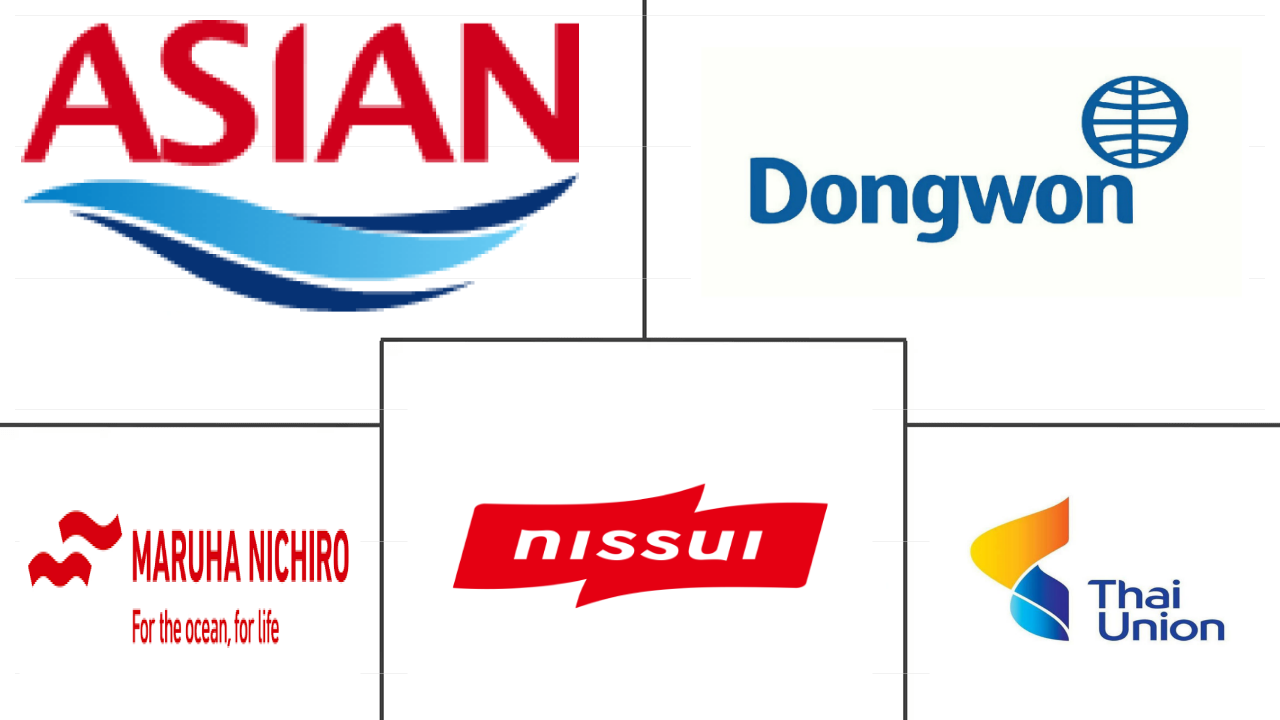Market Size of asia-pacific seafood Industry
| Icons | Lable | Value |
|---|---|---|
|
|
Study Period | 2017 - 2029 |
|
|
Market Size (2024) | USD 497.78 Billion |
|
|
Market Size (2029) | USD 527.34 Billion |
|
|
Largest Share by Type | Fish |
|
|
CAGR (2024 - 2029) | 1.16 % |
|
|
Largest Share by Country | China |
Major Players |
||

|
||
|
*Disclaimer: Major Players sorted in no particular order |
Asia-Pacific Seafood Market Analysis
The Asia-Pacific Seafood Market size is estimated at 497.78 billion USD in 2024, and is expected to reach 527.34 billion USD by 2029, growing at a CAGR of 1.16% during the forecast period (2024-2029).
497.78 Billion
Market Size in 2024 (USD)
527.34 Billion
Market Size in 2029 (USD)
2.41 %
CAGR (2017-2023)
1.16 %
CAGR (2024-2029)
Largest Segment by Type
67.04 %
value share, Fish, 2023
Fish consumption rose in response to the rapid increase in disposable income, as Asian consumers increased their spending on high-quality, value-added fish products.
Largest Segment by Country
49.44 %
value share, China, 2023
Fish was the most-consumed type of seafood in the country, which is dominated by freshwater fish and farmed shrimp, representing 80% of the total consumption value.
Fastest-growing Segment by Type
1.18 %
Projected CAGR, Fish, 2024-2029
The growth of the aquaculture sector supports the progress of the fish market in the region, with farmed fish dominating the on-trade and off-trade distribution channels.
Fastest-growing Segment by Country
2.30 %
Projected CAGR, India, 2024-2029
The rising demand for fresh/chilled seafood like fish and shrimp is expected to drive the growth of the market as India attempts to be self-sufficient with its seafood supply.
Leading Market Player
0.85 %
market share, Maruha Nichiro Corporation, 2022

Maruha Nichiro is known for products like canned seafood and fish sausages for both retail and foodservice, with operations in China, Japan, Thailand, and South Korea.
Increasing in food establishments in the region is boosting the market's growth
- In 2022, the fish type segment occupied a 61% higher market share than the other seafood type segment and a 68.4% higher market share than the shrimp segment. The fish type segment registered a growth of 21.2% by value from 2016 to 2021, mainly due to an increase in the population, which led to an increase in consumer preference for fish due to its affordable cost compared to shrimp and other seafood. In 2022, each person consumed twice as much fish as 50 years ago on average.
- Shrimp is expected to be the fastest-growing seafood type consumed in Asia-Pacific, registering a CAGR of 2.07% by value during the forecast period (2022-2028). China accounts for around 60% of total shrimp sales in the Asia-Pacific region. The increase in HRI players like food establishments rose to 1.2% from 2021, reaching 9.7 million restaurants by 2022 after the COVID-19 pandemic. Food establishments are attracting customers through the change in menus, such as the addition of seafood menus like shrimps and varied tastes of seafood across the Asia Pacific region, which is expected to drive sales and increase market share.
- The COVID-19 pandemic disrupted seafood supply chains through factors such as a shortage of workers and lack of automation, which impacted all stakeholders from 2020 to 2021. To mitigate the risk associated with this type of outbreak, the industry saw increased investments in logistics, packaging, and automation of seafood in countries like China and India. Big companies like Thai Union started using satellite technology for advanced traceability and increased their online presence through food and home deliveries, which further boosted company sales. The industry witnessed around 70 million people shopping online in Southeast Asia from 2019 to 2021.
The market is primarily driven by rising health awareness
- In the Asia-Pacific market, seafood sales increased by 12.99% by value from 2017 to 2022. Non-vegetarian consumers in the region are gradually adopting a more pescatarian lifestyle. Due to customers' growing inclination toward a healthy diet, this movement has been noticed. Asia accounted for 73% of the seafood sales worldwide in 2022 and consumed more than two-thirds of the available seafood supply.
- In 2022, China accounted for a significant share of 49.64% by value in the Asia-Pacific seafood market. The high domestic demand for seafood in China is because of growing consumer perceptions that seafood is a healthy source of protein, along with a rising preference for seafood products among middle-class consumers owing to increasing disposable incomes. With growing spending on seafood in the country, the market is anticipated to experience a growth in demand for high-quality, value-added fish and seafood products.
- Indonesia accounted for the second-highest share in the Asia-Pacific fish market, with 10.44% by value in 2022. The country's government is taking initiatives to protect local fisheries as most of Indonesia’s fisheries are over-exploited or fully exploited, with illegal fishing practices being common. Organizations such as The Nature Conservancy are transforming fishery practices in Indonesia by monitoring fish stocks, tracking fishing vessels, developing species identification technology, promoting rights-based management in small near-shore fisheries, and other initiatives. Japan is one of the other major markets where the government’s Fisheries Agency is working to increase the number of fish caught by improving resource management policies. Such initiatives are increasing the food self-sufficiency rate across Asia-Pacific countries.
